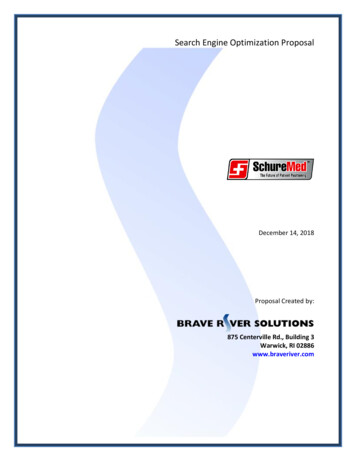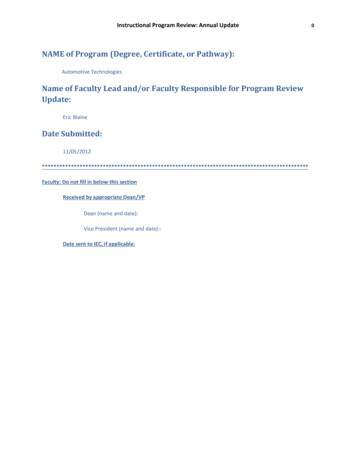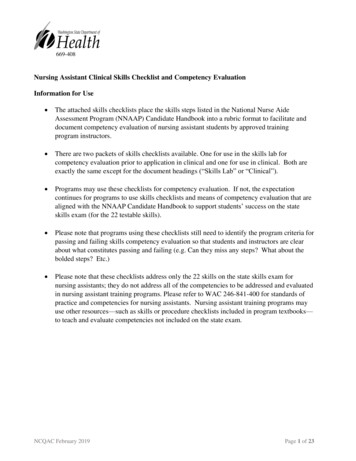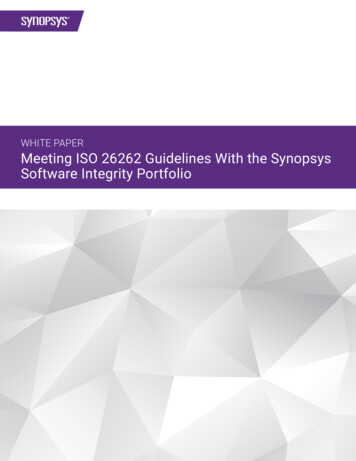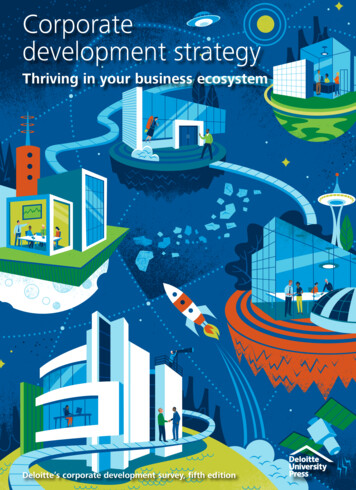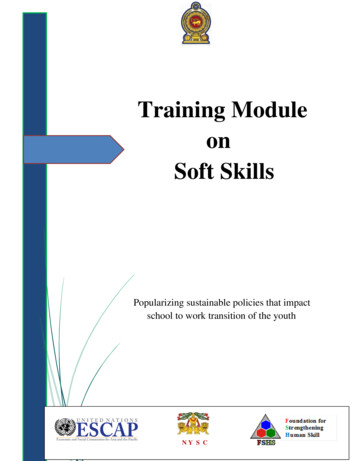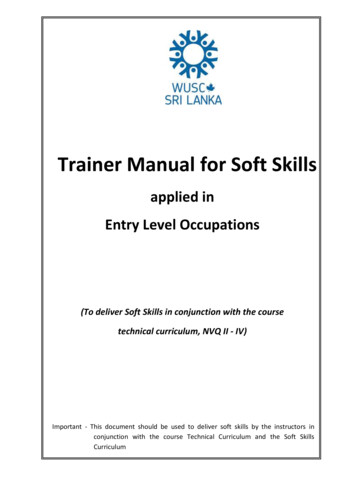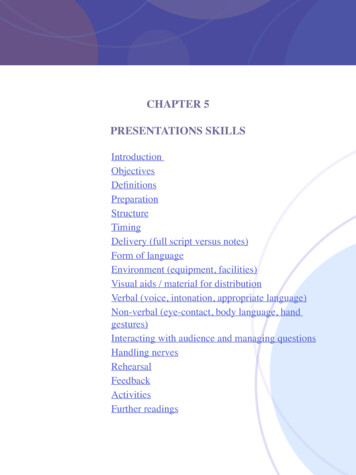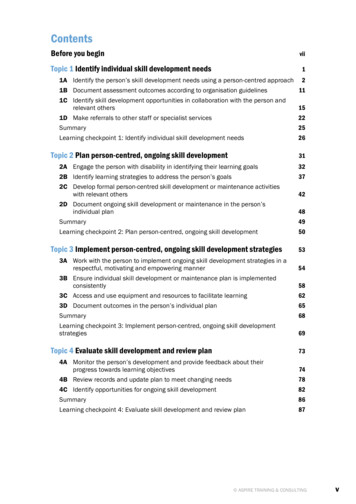
Transcription
ContentsBefore you begin viiTopic 1 Identify individual skill development needs 11A Identify the person’s skill development needs using a person-centred approach 21B Document assessment outcomes according to organisation guidelines 111C Identify skill development opportunities in collaboration with the person andrelevant others 151D Make referrals to other staff or specialist services 22Summary 25Learning checkpoint 1: Identify individual skill development needs 26Topic 2 Plan person-centred, ongoing skill development312A Engage the person with disability in identifying their learning goals 322B Identify learning strategies to address the person’s goals 372C Develop formal person-centred skill development or maintenance activitieswith relevant others 422D Document ongoing skill development or maintenance in the person’sindividual plan 48Summary 49Learning checkpoint 2: Plan person-centred, ongoing skill development 50Topic 3 Implement person-centred, ongoing skill development strategies 533A Work with the person to implement ongoing skill development strategies in arespectful, motivating and empowering manner 543B Ensure individual skill development or maintenance plan is implementedconsistently 583C Access and use equipment and resources to facilitate learning 623D Document outcomes in the person’s individual plan 65Summary 68Learning checkpoint 3: Implement person-centred, ongoing skill developmentstrategies 69Topic 4 Evaluate skill development and review plan 734A Monitor the person’s development and provide feedback about theirprogress towards learning objectives744B Review records and update plan to meet changing needs 784C Identify opportunities for ongoing skill development 82Summary 86Learning checkpoint 4: Evaluate skill development and review plan 87 v
CHCDIS009 FACILITATE ONGOING SKILLS DEVELOPMENT USING A PERSON-CENTRED APPROACHHere is an example of what a skills assessment checklist may include.ABC Disability Support ServicesSkills assessment checklistUn-assistedSome assistancerequiredFull assistancerequiredPrepares meals forselfEats and rs and groomsselfIs continent (boweland bladder)Dresses and puts onshoesTransfers and bearsweightReads andunderstandsdocumentationCommunicatesverballyUse different assessment toolsDuring the formal assessment process a number of different assessment tools maybe used. For any of the assessment tools used, if you notice a change where theindividual can no longer manage a task they used to be able to perform, then a reassessment would be required. Ensure that it was not just a one-off by checkingseveral times under different conditions and on several occasions.Here are examples of some different assessment tools.Different assessment toolsLifestyle planning toolsA lifestyle planning tool helps a person establish life goals andthen an action plan to achieve those goals. This process isusually carried out with help from a case manager, who uses it todetermine what programs need to be put in place.Most lifestyle planning tools identify where assistance is requiredand how success is measured. For those with low literacy orintellectual skills this may be done with pictures.Assessment tools specific to the organisationYour organisation may have its own assessment tools tailored tothe services it offers. These tools identify what services may berelevant to the person. If you are working in education, recreationor vocational training, assessment tools are often competencybased.8 ASPIRE TRAINING & CONSULTING
Topic 1 Identify individual skill development needsAdditional documentsIn addition to checklists, service agreements and individual plans, there are two otheressential documents that are used to record the assessment process.Forms and reportsReassessment request forms or incident reportsWhere a skills assessment is an informal observation process but it is not linked tothe person’s learning plan, you need to document your observations on the relevantform. If you are working as a support worker without direct supervision, this may beby using an incident report form. You may report an incident you have observed ora concern you may have arising from your observations. Some organisations have aseparate form to request a reassessment.A supervisor may choose to undertake a formal reassessment and then negotiatechanges to the person’s individual plan.Communication booksSupport workers need to communicate their observations to other support workersworking with an individual. These observations, including when an incident reportform is lodged, should be documented in the communication book.Document assessment outcomes according to organisationguidelinesClaire is a support worker who is rostered to assist Ianwith home care once a week. Before Claire commencesworking with Ian, she is told that Ian is nonverbal as aresult of an acquired brain injury.Claire and Ian get on well and over the months establisha rapport. Once he feels comfortable with Claire, Ianstarts to communicate using single words or shortphrases such as ‘lunch’, ‘getting tired’ and ‘bathroomdirty’ to express his needs.Claire is pleased they are getting on well and realisesafter this has been happening for a couple of weeks that sheshould document in Ian’s learning plan that Ian can speak whenhe feels comfortable with people.Claire records on the learning plan the times that Ian speaks andunder what circumstances. She also notifies her supervisor byphone and makes an entry in the communication book for othersupport workers.v1708ExampleThe communication book is an open document for all to see. It is to communicatewith other staff and family members and will be seen by the individual themselves.Make sure you write in plain English and record only what you have seen. Do notexpress personal opinions. This is a legal document that could be produced in court. 13
CHCDIS009 FACILITATE ONGOING SKILLS DEVELOPMENT USING A PERSON-CENTRED APPROACHStrategies for identifying opportunitiesFor each of the main personal skill sets there are strategies that can be used toidentify opportunity for development. Life skills, for example, can be taught in differentsettings using different techniques.The following table shows a range of strategies you may use to identify life skillsdevelopment opportunities, and examples for each strategy.StrategyLife skillsFormal trainingTime management trainingCooking classRole modellingSupport workers and supervisor role model work–lifebalanceDemonstrationMeal preparationSkills masteryPractise using public transportContextualisationProblem-solve how to get to the day centreDrama and role-playRole-play getting breakfastPeer educationShare information on decision-makingFurther strategies for identifying skill developmentopportunitiesDifferent people will have differing needs for skill development in the following areas:vocational, social, personal support, relationships, and health and safety skills.Here is an example of skill development opportunities for learning vocational andsocial skills.Vocational skillsFormal training: TAFE coursesRole modelling: support worker and supervisor role model study skills and researchskillsDemonstration: writing a letterSkills mastery: learn to use a computerContextualisation: fill in job application or write a resumeDrama and role-play: role-play a job interviewPeer education: share information on part-time job opportunities16 ASPIRE TRAINING & CONSULTING
CHCDIS009 FACILITATE ONGOING SKILLS DEVELOPMENT USING A PERSON-CENTRED APPROACHIncorporate learning opportunities in an individual planFormal skills assessment and identification of opportunitiesare a component of the person’s annual review. Theirperson-centred plan will be amended to incorporate any newopportunities into a revised plan.If assessment and the identification of opportunities hasbeen part of an informal process, you need to documentyour observations and recommendations. Support workersworking without direct supervision may need to arrange acase conference with a supervisor or the person’s case manager to amend the plan.Check your organisation’s procedures for recommending a formal reassessment or avariation to a person’s plan.A supervisor should then collaborate with the person to check that it aligns with whatthey want and amend the plan and obtain sign-off by all relevant parties. Once again,organisational procedures will determine the process to follow.Collaborate with family and carersDuring the assessment process, you may need to collaborate with the person’s familyand/or primary carer to monitor and assess the skills displayed by the person.18Family membersPrimary carerFamily members can provide informationon the person’s education, professionalhistory, schooling, hobbies, skillsand interests. They can also provideinformation on the person’s relationshipsand how they deal with conflict orfrustration.The primary carer can observe theperson’s abilities and development needswhen the person is not being monitoredby others. The primary carer can alsoprovide information on the person’sformer skill level and any changes theyhave observed. ASPIRE TRAINING & CONSULTING
CHCDIS009 FACILITATE ONGOING SKILLS DEVELOPMENT USING A PERSON-CENTRED APPROACHEmployment officersEmployment officers can conduct an assessment of the person’s pre-employment, oremployability skills.Occupational therapistsOccupational therapists can provide a professional assessment of the person’sphysical skills, mobility issues, and fine motor skills.Programming staffProgramming staff can provide information about the person’s goals and aspirations,and identify the skills necessary to achieve these.TechniciansExampleTechnicians have the ability to use various devices and equipment to assist with theperson’s communication, mobility and motor skills.Identify skill development opportunities in collaboration with theperson and relevant othersSimon is 17 years old and has Down syndrome. As partof his skills identification he says he wants to develophis social skills, find a girlfriend and get to act on thestage. Wendy, his supervisor, helps Simon researchwhat local performance groups are in the area. They usethe local paper and then check through the Arts AccessVictoria website (www.artsaccess.com.au).They locate several performance groups for people withdisability and a theatre group in the area. Simon is nowdeciding which he wants to attend. He thinks he wouldlike to join the theatre group that is run for adolescents in the 14 to 19 age range,and later join the performance group for people with disability once he has developedsome performance skills.Practice task 31. Describe two sources of information you could access to find out about trainingopportunities for a person with disability.20 ASPIRE TRAINING & CONSULTING
Topic 2In this topic you will learnhow to:2A Engage the person withdisability in identifying theirlearning goals2B Identify learning strategiesto address the person’s goals2C Develop formal personcentred skill development ormaintenance activities withrelevant others2D Document ongoingskill development ormaintenance in the person’sindividual planPlan person-centred,ongoing skilldevelopmentThe way services are provided in the disabilityservices sector has changed profoundly through thesocial model of disability. Person-centred planningis an individually-focused approach to planningfor people in need of support and services, andcentres on the unique needs, strengths, preferences,capacities and goals of the individual.Person-centred plans provide a holistic approach toskill development, ensuring a person’s social, sexual,emotional, psychological and cognitive developmentis encompassed. Working in this sector, you need tounderstand the process of person-centred planningand how to engage the person you are supportingin the process. You will become familiar with waysto identify strategies to meet the individual needs ofpeople and develop a formal plan setting out thosestrategies. 31
2BTopic 2 Plan person-centred, ongoing skill developmentIdentify learning strategies toaddress the person’s goalsThis section investigates how you can use a rangeof strategies to address a person’s goals and howthe choice of strategies may vary according to theperson or group of people with disability.Strategies should be selected according toeach person’s disability. Not all strategies areappropriate for all groups. Although you can makesome generalisations, be aware that there willalways be exceptions.Different learning strategiesHere are some different learning strategies andhow they can be used to address the goals of different groups of people you support.Effective learning strategiesRole modellingXX Physical disability: Used to model motivation, communityinvolvement and some life skills.XXCognitive impairment: Used to address socially inappropriatebehaviour along with other strategies.XXIntellectual disability: Used with younger people withintellectual disabilities.XXSensory impairment: Less useful than peer group support.XXPsychological impairment: Used with less-permanentpsychological problems (for example, depression and eatingdisorders) along with other strategies.DemonstrationXX Physical disability: Used in rehabilitation process to learn finemotor skills (for example, new equipment and aids).XXCognitive impairment: Used to teach life skills and mentalactivity (for example, problem-solving).XXIntellectual disability: Used to learn personal grooming, mealpreparation and social skills. Good for concrete thinkers.XXSensory impairment: Difficult to use with vision or hearingimpaired people unless adjustments made.XXPsychological impairment: Some use with phobias andirrational fears. 37
Topic 2 Plan person-centred, ongoing skill development2Performance expectationsPerformance expectations set the standard at which the person will be able toperform and under what conditions. They must be quantifiable so that you canmeasure if they have been met. They must also be realistic and achievable for theperson concerned, and identify whether the performance requires support, or if itcan be achieved unassisted.For example:Aimee will be able to shower herself and wash her own hair to maintain personalhygiene to the level expected by her school and housemates.3Criteria for achievementCriteria for achievement provide a way of judging that the person has achievedtheir desired level of learning and independence with regard to specific learningobjectives. The criteria usually define what the person needs to demonstrate, underwhat circumstances and how many times, in order to establish they are competent.For example:Lorena will be up and ready for school on time every day for a week.4Baseline assessmentBaseline assessment is an assessment of the person’s ability in the area beforetraining. It shows where they have to start from and is used to measure progress.Baseline assessment may include statements such as:5XXthe person can walk 10 metres unassistedXXthe person needs full assistance with mealsXXthe person can communicate yes or no answers only.Formal trainingFormal training includes rehabilitation, attending TAFE courses, skills coaching orany other type of organised training. This section of the plan details if, when andunder what circumstances it is to occur.For example:Luke will attend pre-employment training two days a week (Tuesday and Thursday),commencing 27 November.67Equipment and resourcesEquipment and resources include anything required to assist the person to achievetheir desired level of competence. Examples of equipment include communicationdevices, mobility and lifting devices, voice-activated computers or talking clocks.Examples of resources include material resources (for example, art and craftmaterial, finances or consumables) and human resources (for example, a pageturner, note taker or driver).Prompting and reinforcementThis technique can be used to prompt or verbally assist someone by telling themthe next step if they seem unsure. It is a positive tool to use and should be seen asencouraging rather than correcting or nagging.Reinforcement means to give added support, either by repeating the act to gaincompetence or by there being a positive outcome to undertaking the task. 43
ExampleCHCDIS009 FACILITATE ONGOING SKILLS DEVELOPMENT USING A PERSON-CENTRED APPROACHDevelop person-centred skill development activities with othersSophie Madison is a person with a mild intellectual disability who wants to becomea chef. Her person-centred activities are drawn up at the time of planning. Sectionson progress and independence, prompting and evidence will be completed as Sophieprogresses.This is the plan drawn up for Sophie.ABCDisability Support ServicesName: Sophie MadisonCommencement date: 30 October 2015Learning objective:To undertake vocational training to be a chefPerformance expectations:Sophie will enrol and attend vocational training and complete the program possibly as atraineeship or apprenticeship.Criteria for achievement:XX Achieve literacy skills to standard required for course entryXXEnrol in course and attend regularlyXXComplete all course work including practicalXXGraduate from course as a chefFormaltrainingEquipmentandresourcesProgress andindependencePrompting catecourse TAFEChef kitCoursematerialsSequence of training:Literacy trainingCertificate course as chefAssistance required:Support worker to demonstrate and role modelDietitian to provide information in accessible formEvaluation methods: role-play, simulation, demonstration46 ASPIRE TRAINING & CONSULTINGEvidencesigned
Topic 2 Plan person-centred, ongoing skill developmentUse the SMART goal-setting formula: specific, measureable, achievable, realistic andtime-based.XXUse dot points or numbering for action plans or when breaking down a task.XXInitial any changes or variations, sign and date all entries, and ask the person to sign.ExampleXXDocument ongoing skill development in the person’s individualplanGlenda lives in a shared house with four other residents.When she is asked to set some personal goals, all shecan think of is that she wants a dog.Her support worker helps Glenda decide what sort of dogshe wants by looking at a series of pictures. They thencut out a picture of the breed of dog Glenda wants andstick it on a chart. Glenda and her support worker thenwork out what she needs to do before she can get a dogand what she needs to learn to look after it.They write in simple sentences and put a picture with each point so Glenda can followthe plan.Practice task 8Prepare and conduct an interview with a disability support worker or manager. Identifyhow the worker ensures ongoing skill development is documented effectively in aperson’s individual plan. Identify how the person makes adjustments to their writtencommunication to ensure the information is accurately recorded and understood bythe person with disability.Click to complete Practice task 8Summary1. Use active listening and culturally appropriate communication techniques toestablish a rapport with people you support to engage them in the planningprocess.2. Identify the strategies most appropriate to an individual’s learning goals, andunderstand the different theories of how people learn under various conditionsand at various stages of their lives.3. Ensure a person’s skill development or skill maintenance plan includes appropriateservices and learning processes that support the person’s individual needs. Thisenables the person to maximise their potential in the areas identified by theirindividual goals.4. Document ongoing skill development in the person’s individual plan in plainEnglish, being mindful that it could be a legal document.5. Consider the use of pictures and storyboards for people with intellectual disabilitiesor cognitive impairment. 49
Topic 3In this topic you will learnhow to:3A Work with the person toimplement ongoing skilldevelopment strategies in arespectful, motivating andempowering manner3B Ensure the individualskill development ormaintenance plan isimplemented consistently3C Access and use equipmentand resources to facilitatelearningImplement personcentred, ongoing skilldevelopment strategiesWhether you are employed as a support workeror a supervisor in the disability sector, you will berequired to help implement skill development plans.This involves encouraging and motivating the peopleyou support and providing positive reinforcementto their learning. You must also ensure the planis implemented in a consistent and respectfulmanner that acknowledges their individual needsand learning style. You may need to draw ondifferent learning strategies and access a variety ofequipment and resources. You will also be involved indocumenting their progress.3D Document outcomes in theperson’s individual plan 53
Topic 3 Implement person-centred, ongoing skill development strategies3Recreational officers, lifestyle and leisure consultantsXX Information on how activities are integrated into the development planXX4The current level of performance that can be expectedPhysiotherapists or occupational therapistsXX Baseline assessment and expected outcomesXXTime lines and activities to be undertakenXXThe current level of performance that can be expected5DietitiansXX Any special requirements regarding nutrition and hydration6Education psychologistsXX Support and encouragement strategies that are in place; expectedoutcomesXXAssistance they can offer for holistic growthTeachersXX The program or plan the person has commenced78910XXDesired outcomesXXAny special needs such as communication devices; other resources suchas scribes and note takersXXInformation on the current level of performance that can be expectedDevelopment officersXX The program the person has in place and their role, plus the role of othersEmployment officersXX Expected outcome of program and time linesXXAny vocational component of the programXXInformation on the current level of performance that can be expectedTechniciansXX Any special assistance, equipment or devices requiredXXInformation on the current level of performance that can be expectedGuidelines on sharing informationYou need to be aware of your organisation’s guidelines on the sharing of information.There are a number of policies and procedures you have to be familiar with, including:privacy and confidentialityXX duty of care and dignity of riskXX informed choiceXX record maintenanceXX organisational guidelines for sharing information.XX 59
CHCDIS009 FACILITATE ONGOING SKILLS DEVELOPMENT USING A PERSON-CENTRED APPROACHGuidelinesWhere the change in a person’s skill level requires a change to guidelines, you needto follow workplace procedures as this also involves a change to the quality system.An example would be if you change guidelines for support workers assisting peopleto access an ATM.Communication booksA communication book is used to communicate information between supportworkers, the family, the person and other relevant health professionals. It remains inthe person’s home and is an open document for all to see. Entries must be fact, notopinion; report only what you have observed. All entries should be signed and dated.Files notesWhen you have had a face-to-face discussion with the person about their skilldevelopment progress, record the conversation in a file note. Follow workplaceprocedures, as file notes are a legal record of dialogue.Staff meetingsA person’s skill development requirements may be discussed at a staff meeting. Inorder to disseminate information, it should be shown on the agenda and added tothe meeting minutes.Training sessionsWhere training or an information session is run for staff who will be working with aperson in their skill development, this information should be recorded as a file noteand in the support worker’s training record.Case management meetingsA formal agenda and minutes should be recorded for case management meetings.This is usually undertaken by the case manager.The importance of documentationv0350You will generally be given information about documentation needed in your workrole as part of your induction process and on an ongoing basis by your team leader ormanager. You can also consult your organisational policies and procedures, which willbe provided in hard copy and/or in electronic format. Depending on your role, you maybe regularly involved in the process of reviewing and updating policies and procedures.66 ASPIRE TRAINING & CONSULTING
Topic 4In this topic you will learnhow to:4A Monitor the person’sdevelopment and providefeedback about theirprogress towards learningobjectives4B Review records and updateplan to meet changingneeds4C Identify opportunities forongoing skill developmentEvaluate skilldevelopment and reviewplanA skill development plan should be considered aliving document to be reviewed and amended asthe person progresses toward their goals. To reviewa skill development plan, you need to evaluate theperson’s progress and provide feedback to them,their carer and relevant others for the person’sdevelopment. This, in turn, should lead to a seriesof discussions to identify new opportunities for skilldevelopment. 73
CHCDIS009 FACILITATE ONGOING SKILLS DEVELOPMENT USING A PERSON-CENTRED APPROACHHealth skillsXXMaintaining physical health (including sexual health)XXJoining a gym, yoga, dance or exercise groupXXHaving regular health check-upsXXJoining education programs; for example, family planning, orLGBTQ Youth ProgramsSafetyXXHaving regular health check-upsXXFollowing safe sex proceduresXXTaking part in a self-defence clubOpportunities within the communityWhen identifying learning opportunities thatcan provide ongoing skills enhancement, thebest source of information may be the personthemselves. In addition, you could consult withother health professionals to help you identifylearning opportunities.ExampleOpenings that offer ongoing opportunities forskills enhancement are not restricted to thoseopportunities within the disability sector. Tosupport both community integration and ongoingskill opportunities, you may choose to identifyclubs, associations and employment that areavailable to the broader community.84Identify opportunities for ongoingskill developmentSonia wants to improve her social skills, including herability to talk to people and make friends. She also likesto express herself through singing. Her supervisor, Chris,puts her in touch with the local women’s choir. Soniajoins the choir and it gives her an outlet for developingher singing skills and social interaction. ASPIRE TRAINING & CONSULTING
Topic 5In this topic you will learnhow to:5A Identify informal learningopportunities andencourage learning5B Provide prompt andconstructive advice in anappropriate format5C Provide encouragementwhen the person takesinitiative5D Withdraw support toan appropriate level toencourage experientiallearning and developmentUse incidental learningto enhance skilldevelopmentWhen creating and documenting a person-centredskill development plan you can assist a personwith disability to systematically achieve theirlearning goals. However, much can also be gainedthrough incidental learning, which is the largelyunstructured and unplanned learning that happensas a consequence of what is going on around us.As a supervisor or experienced support worker, youshould try to incorporate incidental learning into theday-to-day activities of a person you are supportingand facilitate their skill growth through a moreinformal process. 91
CHCDIS009 FACILITATE ONGOING SKILLS DEVELOPMENT USING A PERSON-CENTRED APPROACH5AIdentify informal learningopportunities and encouragelearningInformal learning opportunities arise out of theeveryday activities undertaken by a person withdisability. Having conversations, observing others,trial and error, and working with experiencedothers all allow a person to acquire new skillsin an unofficial, unscheduled manner. As asupervisor or experienced disability supportworker, you should identify informal or incidentallearning opportunities for the person you supportand encourage their active participation.Formal, informal and incidentallearningIt is important to understand the differences between formal, informal and incidentallearning to ensure you plan skill development activities that best suit the needs,preferences and lifestyle of the person you support.Formal learningFormal learning opportunities include enrolling in a TAFE oruniversity course, attending school, joining a swimming team,attending coaching or enrolling in a cooking course.Formal learning always includes an agreement on what is to belearnt, the time frame and the roles and responsibilities of thelearner and the trainer. On completion of the training it is expectedthat the learner will have gained knowledge, skills and abilities.Informal learningInformal learning opportunities include learning how to bake acake by watching someone, asking someone to show you dancemoves or joining a theatre company.In informal learning, there is no contact or time frame and the rolesand responsibilities of the learner and the trainer are not defined.There are no learning outcomes or standards that should beachieved. If either party wants to stop the process, they can.Incidental learningIncidental learning happens all the time. For example, if you enrolin a TAFE course, you will also learn how to get up on time, manageyour time, pack your lunch, get along with other students and usethe internet for research. These are not things that you agree to orset out to learn. Instead, you learn them incidentally along the way.Incidental learning takes place wherever the learner happens to beand occurs as a consequence of other activities.92 ASPIRE TRAINING & CONSULTING
Topic 5 Use incidental learning to enhance skill developmentTypes of
A lifestyle planning tool helps a person establish life goals and : . Communication books: Support workers need to communicate their observations to other support workers : . Person-centred plans provide a holist

